The Emerald Ash Borer Is In Kansas City
The Emerald Ash Borer (Agrilus planipennis Fairmaire)—commonly called the EAB—is an exotic beetle that has worked its way to the Kansas City area, including Johnson County. A member of the Buprestid, or jewel-beetle family, EAB beetles are native to northeastern Asia and were likely introduced to America in packing materials used on cargo ships.
Though it usually only attacks ash trees (Fraxinus spp.), and sometimes fringe trees, EAB are considered one of the most destructive tree pests in North America. As of June 2022, it has been verified in 36 of the 50 states (primarily midwestern and eastern areas of the US) and parts of southern Canada, and is spreading fast.
Adult EAB beetles are an easily recognizable metallic green color and measure one-half inch long and one-eighth inch wide, easily fitting on a penny.
Problems Caused By The Emerald Ash Borer
Adult EAB beetles cause minor damage compared to the newly hatched, immature larvae. The adults may nibble on the foliage but rarely eat enough to impede photosynthesis or defoliation. However, adult beetles are responsible for laying their eggs within the bark of ash trees, which is the root of the problem.
Once the larvae hatch from the eggs, they feed on the inner bark layer of ash trees known as the cambium, the bright green ring you can see when a branch is cut or broken. Since this ring is responsible for transporting water and nutrients between the roots and canopy, EAB larvae can bring extensive damage over time.
As the larvae feed, they can girdle branches and kill the entire tree within a few seasons. Smaller or immature trees can die as early as one or two years after infestation. Larger, established trees may survive three or four years after infestation.
While the loss of a tree may not seem like a big deal, EABs have very few natural predators, and so have exponentially spread, causing significant damage.
- EAB has killed hundreds of millions of ash trees across North America.
- EAB has caused the USDA and state regulatory agencies to enforce quarantines and associated fines to prevent moving potentially infested ash wood into non-infested areas.
- EAB has cost homeowners, municipalities, nurseries, and forest products industries upwards of hundreds of millions of dollars.
How To Spot Ash Tree Issues
At first, you may overlook EAB problems because the symptoms often mimic damage from other diseases, insects, or environmental stressors, however there are a few symptoms of their presence.
The telltale signs of Emerald Ash Borer infestation include yellowing leaves, D-shaped holes in the bark, S-shaped tunnels under the bark, thinning or dieback of the canopy, and bark loss.
You typically also see shoots growing from the tree’s base with larger than normal leaves. This growth occurs because the larvae have stopped water and nutrient movement to the top of the tree, so the tree tries to send out new growth from the roots.
Heavy woodpecker activity and resulting bark damage may also indicate EAB infestation, as woodpeckers will search for EAB larvae, though they will generally leave the adults alone.
Are Your KC Trees Infected?
If you think your ash trees are infested with EABs, the first step is to inspect the trees closely. Look for D-shaped holes in the bark—these are exit holes made by the adults when they emerge. You can also peel off small bark sections to look for characteristic S-shaped tunnels.
Once confirmed, record where you found the emerald ash borer, taking pictures of the damage and living insects. Because EAB infestations are so serious and widespread, you should call the USDA Emerald Ash Borer Hotline (1-866-322-4512) or contact your local USDA Animal and Plant Health Inspection Service (APHIS) office. They will provide you with the necessary equipment.
What Can I Do to Prevent Emerald Ash Borer Problems?
There are three key ways to prevent Emerald Ash Borer problems, whether or not they are currently infesting your ash trees.
Any ash trees growing within fifteen miles of a confirmed infestation are at risk of EAB attack. If you live in a risk zone, it’s suggested you apply preventative treatments to all of your ash trees. Preventative treatments may be premature if you live outside of the fifteen-mile radius.
It is also imperative to be mindful of any firewood you have, as infested firewood contributes significantly to the spread of the emerald ash borer. Never move firewood from your property to another location, and if you have a winter firewood supply, make sure it is all burnt before spring.
Another way to prevent your trees from an EAB attack is to keep them healthy and thriving. Ensure they are adequately watered and pruned, and avoid wounding your trees with lawn equipment.
If your Kansas City area home has ash trees, you need to call Ryan Lawn & Tree for your custom EAB preventative treatment.
Kansas City Emerald Ash Borer Treatment
To treat the EAB, it is best to use a systemic insecticide versus a contact insecticide.
Systemic chemicals are absorbed into the tree and moved through the tree’s vascular system. They are transported from the roots to the trunk, the branches and leaves, affecting all parts.
A contact insecticide isn’t absorbed by the plant tissue. It only kills insects with which it comes in direct contact, limiting its effectiveness to the application area.
Standard insecticide application methods include trunk injections, soil injections, soil drenches, and basal trunk sprays.
Trunk Injections
With trunk injections, professionals use specialized equipment to inject the insecticide inside the tree. It costs more but minimizes drift, runoff, and non-target organism exposure.
Ryan Lawn & Tree’s prefered EAB treatment is an emamectin benzoate injection. Trees tolerate the small, shallow injections, and the injection holes will eventually close. This method can be done regardless of the weather or soil characteristics and works quickly. The insecticide makes its way through the tree in one to four weeks—much quicker than soil-applied treatments.
Soil Injections
Soil injections place product two to four inches below the soil surface within eighteen inches of the trunk or in a grid pattern within the canopy’s dripline. Product drift and runoff are minimized with this method as well, but it also has to be done by a professional service.
Soil Drench
When using a soil drench product, the insecticide is poured directly onto the soil over the tree’s roots. Soil drenching doesn’t damage the tree and doesn’t require any special equipment, but it does have a high potential for runoff. A soil drench should never be used when the soil is frozen or saturated.
You can apply soil drench products like imidacloprid to trees with a trunk diameter at breast height (DBH) of less than fifteen inches. These products are best used in summer, typically between May 1st and June 15th.
Basal Trunk Sprays
Basal trunk sprays are applied to the trunk from the soil surface, covering the roots up four to five feet. The trunk sprays are best for smaller trees but may need to be used with a surfactant so the insecticide adheres well to the bark.
Do You Need Help Treating Emerald Ash Borer?
An Emerald Ash Borer infestation can be a life sentence for your ash tree(s), and is something that needs to be treated quickly. If you think you have an issue on your property or are looking for treatment services, let the professionals at Ryan Lawn & Tree help!
Kansas City
-
5425 Antioch Dr.
Merriam, KS 66202 - 913.381.1505
-
Hours
Office Hours:
7:30am-5:00pm Monday-Friday
Closed Sunday - Connect
Give Ryan Lawn & Tree a call at 913-381-1505 or schedule a free Emerald Ash Borer quote online! Our RYAN EAB Pros will apply a custom EAB treatment for your ash tree.
Serving Kansas City and Surrounding Areas Since 1987!
Our Ryan Lawn & Tree branch location in Merriam, KS allows us to better serve our neighbors throughout the KC metro area, including those in Jackson County, Wyandotte County & Johnson County, KS









